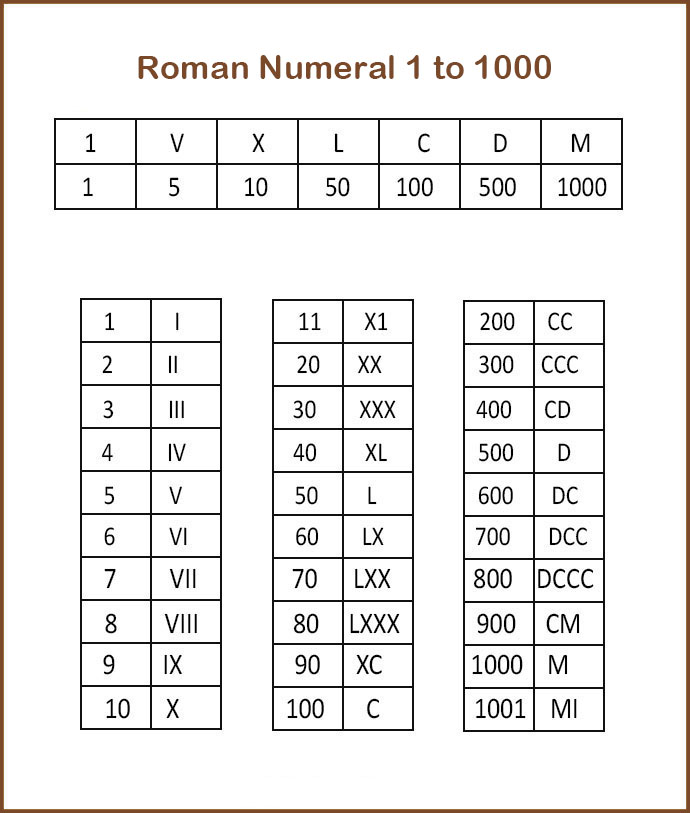Ancient Romans used letters to write numbers even today the building date on monuments and public buildings are marked In Roman numerals and we also use roman numerals in clocks and watches. Go through the complete article to be well versed with details like Definition, Chart, Conversion from Roman Numerals to Numbers, Conversion of Numbers to Roman Numerals. Also, refer to Solved Examples for writing Roman Numerals and understand the concept well.
Below the letters used to write numbers
| Symbols | I | V | X | L | C | D | M |
|---|---|---|---|---|---|---|---|
| Numbers | 1 | 5 | 10 | 50 | 100 | 500 | 1000 |
Read More:
- Rules For Formation of Roman Numerals
- Conversion of Roman Numerals to Numbers
- Conversion of Numbers to Roman Numerals
Roman Numeral Chart for 1-1000 Numbers
Here is the list of commonly used Roman Numerals for Numbers 1-1000. They are as such

Rules for Writing Roman Numerals
We need to remember three rules while writing roman numerals
- Rule of repetition
- Rule of addition
- Rule of subtraction
Now let’s see what are these rules
Rule of Repetition
This rule states that whenever a symbol is repeated twice or thrice, its value is multiplied by 2 or 3 respectively. This means if a symbol is repeated two times then the value of that symbol should be multiplied twice.
Example:
| Roman Numerals | M | MM | MMM |
|---|---|---|---|
| Hindu-Arabic Numerals | 1000 | 2000 | 3000 |
As we already know Value of M is 1000
When M is repeated twice, the value of M should be multiplied two times which is
M * M = M*2 = 1000 * 2 = 2000.
In the same way, when M is repeated thrice the value of M should be multiplied three times so
M * M * M = M*3 = 1000 * 3 = 3000.
Among all the roman numerals, few symbols I, X, C, and M can only be repeated three times at maximum. Example:
| Hindu-Arabic numerals | 1 | 2 | 3 | 4 |
|---|---|---|---|---|
| Roman Numerals | I | II | III | IV |
We can write 1 as I, 2 as II, 3 as III in the Roman system but we can’t write 4 as IIII instead 4 will be written as IV
Among all the roman numerals few symbols V, L, and D should not be repeated. This means the symbols for 5, 50, and 500 can’t be repeated.
Example:
| Hindu-Arabic numerals | 10 | 10 |
|---|---|---|
| Roman Numerals | VV | X |
Explanation:
As stated we do not write the number 10 by repeating V but as X
Rule of Addition
This rule states that if a symbol of a smaller value is written to the right of a symbol of higher value, we add the smaller value to the greater value.
Example
Let’s take one symbol XI here as we already know X is 10 and I is 1 now we have to add 10 to 1 (10+1) which is 11 so here Hindu-Arabic numeral of XI is 11
Rule of Subtraction
This rule states that if a symbol of a smaller value is to the left of a symbol of a higher value, we subtract the smaller value from the higher value.
Example:
Let’s take one symbol XC here as we already know X is 10 and the value of I is 100 now we have to subtract 10 from 100 (100 -10) which is 90 so here Hindu-Arabic numeral of XC is 90
Few roman numerals symbols V, L and D can’t be subtracted from any other numbers. Let me give one example for better understating
Example
The Roman numeral of 95 is XCV
95 can’t be written as 95 = 100 – 5 = VC
95 should be written as 95 = 90 + 5 = XCV
As mentioned we should not subtract V from other symbols.
Roman numerals symbols I, X, and C are used to subtract from any other numbers. There are just six combinations that are usually followed while subtraction as mentioned below.
IV = 5 – 1 = 4
IX = 10 – 1 = 9
XL = 50 – 10 = 40
XC = 100 – 10 = 90
CD = 500 – 100 = 400
CM = 1000 – 100 = 900
So these are the 3 rules that everyone should follow while writing roman numerals.
